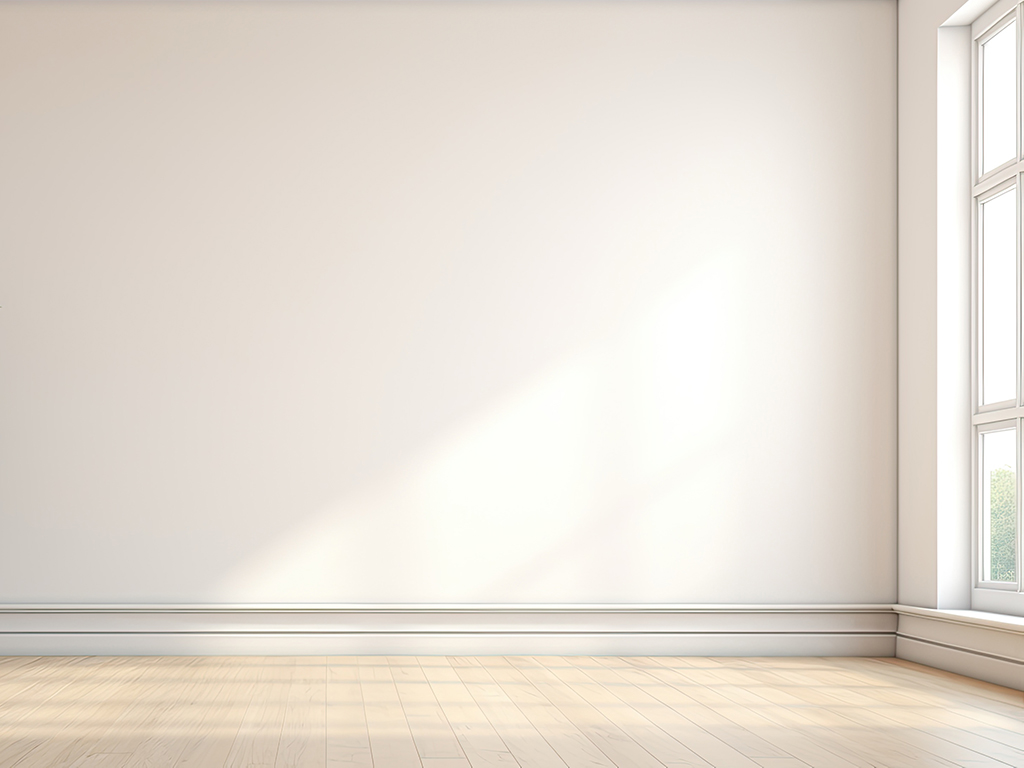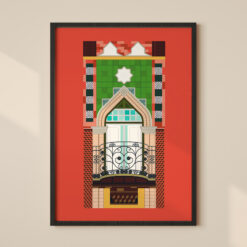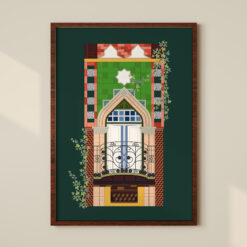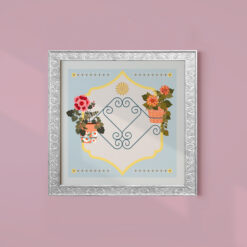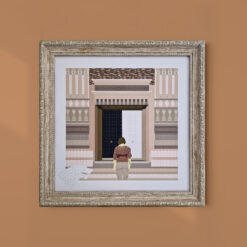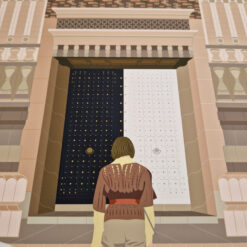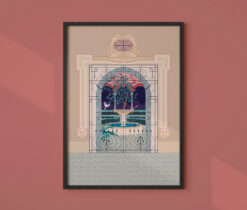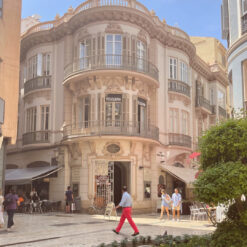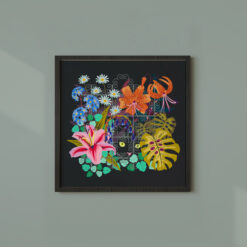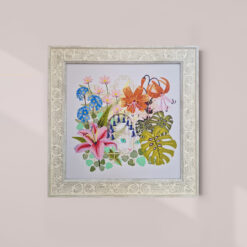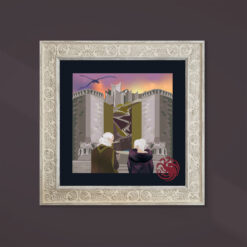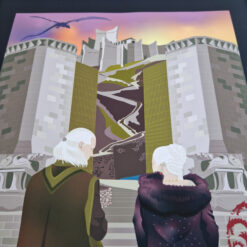Uncategorized
Dopamine Décor: Colourful wall art to improve your mood
A blank wall…
Gives the opportunity to drastically change the appearance and feel of a space in our homes.
When decorating your home, it is always important to take the necessary time to decide what colour/s to use, choosing one or several artistic styles that best match your personality… because for many, home decor is important – we need to feel comfortable at home so that it improves our well-being.
Home interior decoration trends vary every few years between minimalism and maximalist, but there is a trend that is here to stay: “dopamine decor”. The goal is to reflect your personality in your home by choosing colours and furniture that evoke joy, happiness, and ultimately positive emotions.
What is a dopamine décor?
Dopamine is a neurotransmitter—a chemical messenger in the brain that plays several important roles in various brain functions, one of them is to make us feel good, generating feelings of pleasure and positive emotions.
You can get those feelings, to an extent, just by using your favourite bright colours to decorate your home. Interesting furniture can also help in this regard.
If you have already seen our illustrations and products, you will have noticed that at About My Prints, we go for bright and vibrant colours. This is because studies show that it can improve our mental health and emotional well-being by conveying positive emotions – this is the essence of dopamine decor.
How does art influence and stimulate brain functioning?
Art has different effects on the brain; it can be used as a tool to reduce stress and anxiety, promote relaxation and meditation, and evoke positive emotions and feelings.
There is a field in experimental science known as neuroaesthetics that investigates the (neuro)psychological relationship we have with aesthetics. That is, it explores our perception and response to art, beauty, creativity or interactions with objects and scenes that evoke an intense feeling, often of pleasure, and how this can improve our quality of life, mental health, memory, learning, etc.
Neuroaesthetic researchers, such as Semir Zeki, a neurobiologist specializing in understanding how the brain responds to visual stimuli, are also studying how the brain reacts to seeing or creating art.
The part of our brain responsible for releasing chemicals that make us feel good, such as dopamine, serotonin, and oxytocin, generates feelings of pleasure and positive emotions in the individual. These pleasure centres in the brain are activated when we create and contemplate the arts or participate in experiences that we enjoy.
Art is a form of creative expression that can be appreciated and created by any of us, by people of all ages and cultures. Through art, we can communicate our feelings and emotions, sometimes positive (happiness) and other times negative (pain)…but it can affect us differently depending on our mood or personality.
Studies have shown that it can serve as therapy to treat some mental illnesses. For others, it can serve as a relaxation technique and an escape from stress or a way to face fears and negative emotions.
As mentioned before you can engage with art, as a creator or spectator, and this stimulates brain activity in multiple areas, enhancing neural connectivity.
Here’s how this works:
Creating and/or appreciating art can activate different regions of the brain, encouraging communication between these areas. This increased activity can strengthen the connections between neurons, promoting overall brain health.
Art activities stimulate areas involved in sensory processing, emotions, memory, and motor skills.
Engaging in artistic activities can promote neuroplasticity, which is the brain’s ability to reorganize itself by forming new neural connections. This can improve cognitive functions and potentially aid in recovery from brain injuries.
Artistic activities often require problem-solving, critical thinking, and emotional expression, which can enhance cognitive abilities and emotional regulation. This can lead to improved mental health and cognitive recovery.
Art therapy helps people to deal with stress, trauma, and mental health issues. It can facilitate emotional expression, communication and processing, contributing to better mental health and well-being.
Interior design is a form of art.
Choosing combinations of interesting colours and patterns that are both functional and reflective of your personality can be challenging, but once you’ve decided and are happy with the result, it is very rewarding.
Each of us has different and varied tastes, and decorating your home can be both a challenge and an enjoyable activity. Here are some ideas to help you get started:
a. Choose soft base colours, bright-coloured accessories.
Even though dopamine decor focuses on vibrant and energetic colours, it doesn’t mean you have to use them on all the walls or furniture in your home. You can use softer base colours or earth tones associated with nature and choose strong, vibrant tones for the accessories in the room. This way, the contrast will be greater.
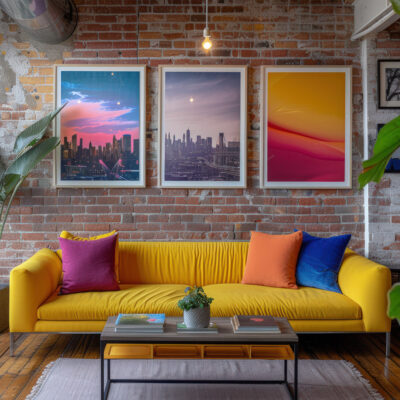
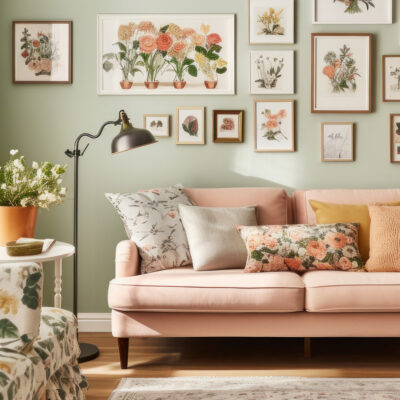
b. Add elements to the decor that you like and that have value for you and those who live with you.
They can be family photos, travel souvenirs, etc., elements that represent your hobbies or tastes. You can’t decorate your entire home with family photos and souvenirs, but it should at least be part of it.
c. Play with textures and materials prioritizing your comfort.
Different textures in the space can improve your mood. Consider which materials make you feel more comfortable and happy at home. For example, would you prefer a plush wool rug or a soft jute rug? An elegant leather sofa or a comfortable and soft cotton fabric sofa?
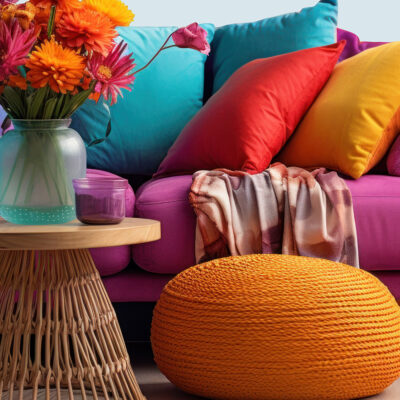
How colourful art improves your emotional well-being?
If you have taken a look at the illustrations of About My Prints, almost all of them have vibrant and striking colours. Some studies of how colours influence our mood and emotions reveal that certain colours have the same impact on each of us, regardless of gender, age, social status, or culture.
There are certain colours that are often associated with similar feelings. For example, joy and energy are associated with the same colours. The same goes for fidelity and trust. It should be noted that the combination of various colours conveys different emotions depending on the colours we use. For example, the combination of red and black does not produce the same effect as red and yellow.
According to colour theory, there are three primary colours: red, yellow, and blue. By mixing two of them, you get secondary colours (green, orange, violet). These colours can be lightened or darkened by adding white or black, respectively. Tertiary colours result from mixing all three primary colours. However, mixing the three primary colours (red, yellow, and blue) plus additional colours can lead to muddy colours which is not advisable.
Let’s analyse how certain colours affect us and what they evoke:
❤️Red, 🧡Orange, and 💛Yellow.
These warm and lively colours excite our nervous system. They activate and transmit energy. They encourage activity and give us encouragement and motivation. If you want to decorate a room with colours that transmit energy and activity, these illustrations are some of my favourites.
Art Giclée Prints
🩵Blue, 💚Green, and 💜Lilac.
If you prefer calm and relaxation, these colours convey tranquillity and relaxation.
The colour blue can seem cold, but it also conveys good feelings except for those dominated by passion. Some examples of these emotions are calm, tranquillity, trust, and friendship. It hardly has any negative connotations, which is why it is widely accepted and tends to be one of the favourites.
Art Giclée Prints
🤍White and 🤎Beige
They are not characterized by producing emotional changes although the colour white has a lot of symbolism; it represents clarity, day, and a beginning. It is also associated with the divine.
Both colours allow us to achieve a minimalist environment. These colours are ideal in spaces where you need to concentrate.
Art Giclée Prints
Art Giclée Prints
🩷Pink
It conveys kindness, innocence, and good intentions, although it is also associated with being childish.
🖤Black and 🩶Grey
In the wrong context, these colours can evoke negative feelings, such as sadness or pessimism, but as part of the design of a room can evoke positive ones, such as elegance, seriousness, power, or efficiency.
Art Giclée Prints
Art Giclée Prints
Rhaenyra Targaryen and Daemon Targaryen at Dragonstone. Team Black Print
These illustrations have been suggested in the article because there is a predominant colour in them. However, in all the prints, we can appreciate multiple colours. Why? My goal is to add depth and emotion to my drawings. Also I try to focus the viewer’s attention on details that might otherwise go unnoticed.
If you want to read more about the effect that colours have on our emotions or mood have a look at the book by Eva Heller, “Colour Psychology: How Colours Act on Feelings and Reason,” a German author and researcher specializing in the psychology of colours.
If you found this article interesting, you can leave your opinion or reflections in the comments.
Thank you very much!
References
- Essays on science and society. Artistic creativity and the brain. Semir Zeki. 2001 Jul
- Neural Correlates of Beauty. Hideaki Kawabata and Semir Zeki. 2004 Apr
- Your Brain on Art: The Case for Neuroaesthetics. Susan Magsamen. 2019 Jul
- Colour Psychology in Art: How Colour Impacts Mood. Ali Redha Hussain. 2021 Nov
- Can a Brief Interaction With Online, Digital Art Improve Wellbeing? A Comparative Study of the Impact of Online Art and Culture Presentations on Mood, State-Anxiety, Subjective Wellbeing, and Loneliness. MacKenzie D. Trupp et al. 2022 Jun
- Do we enjoy what we sense and perceive? A dissociation between aesthetic appreciation and basic perception of environmental objects or events. A. K. M. Rezaul Karim et al. 2022 Oct

